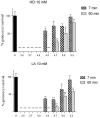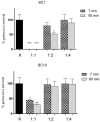Vaginal Lactobacilli Reduce Neisseria gonorrhoeae Viability through Multiple Strategies: An in Vitro Study
- PMID: 29270390
- PMCID: PMC5723648
- DOI: 10.3389/fcimb.2017.00502
Vaginal Lactobacilli Reduce Neisseria gonorrhoeae Viability through Multiple Strategies: An in Vitro Study
Abstract
The emergence and spread of antimicrobial resistance in Neisseria gonorrhoeae (GC) underline the need of "antibiotic-free" strategies for the control of gonorrhea. The aim of this study was to assess the anti-gonococcal activity of 14 vaginal Lactobacillus strains, belonging to different species (L. crispatus, L. gasseri, L. vaginalis), isolated from healthy pre-menopausal women. In particular, we performed "inhibition" experiments, evaluating the ability of both lactobacilli cells and culture supernatants in reducing GC viability, at two different contact times (7 and 60 min). First, we found that the acidic environment, associated to lactobacilli metabolism, is extremely effective in counteracting GC growth, in a pH- and time-dependent manner. Indeed, a complete abolishment of GC viability by lactobacilli supernatants was observed only for pH values < 4.0, even at short contact times. On the contrary, for higher pH values, no 100%-reduction of GC growth was reached at any contact time. Experiments with organic/inorganic acid solutions confirmed the strict correlation between the pH levels and the anti-gonococcal effect. In this context, the presence of lactate seemed to be crucial for the anti-gonococcal activity, especially for pH values in the range 4.4-5.3, indicating that the presence of H+ ions is necessary but not sufficient to kill gonococci. Moreover, experiments with buffered supernatants led to exclude a direct role in the GC killing by other bioactive molecules produced by lactobacilli. Second, we noticed that lactobacilli cells are able to reduce GC viability and to co-aggregate with gonococci. In this context, we demonstrated that released-surface components with biosurfactant properties, isolated from "highly-aggregating" lactobacilli, could affect GC viability. The antimicrobial potential of biosurfactants isolated from lactobacilli against pathogens has been largely investigated, but this is the first report about a possible use of these molecules in order to counteract GC infectivity. In conclusion, we identified specific Lactobacillus strains, mainly belonging to L. crispatus species, able to counteract GC viability through multiple mechanisms. These L. crispatus strains could represent a new potential probiotic strategy for the prevention of GC infections in women.
Keywords: Lactobacillus; STIs; gonococcus; gonorrhea; probiotics.
Figures





Similar articles
-
In-vitro effect of vaginal lactobacilli against group B Streptococcus.Microb Pathog. 2019 Nov;136:103692. doi: 10.1016/j.micpath.2019.103692. Epub 2019 Aug 21. Microb Pathog. 2019. PMID: 31445119
-
Lactobacillus crispatus inhibits growth of Gardnerella vaginalis and Neisseria gonorrhoeae on a porcine vaginal mucosa model.BMC Microbiol. 2015 Dec 9;15:276. doi: 10.1186/s12866-015-0608-0. BMC Microbiol. 2015. PMID: 26652855 Free PMC article.
-
The role of acidification in the inhibition of Neisseria gonorrhoeae by vaginal lactobacilli during anaerobic growth.Ann Clin Microbiol Antimicrob. 2011 Feb 17;10:8. doi: 10.1186/1476-0711-10-8. Ann Clin Microbiol Antimicrob. 2011. PMID: 21329492 Free PMC article.
-
The human vaginal microbial community.Res Microbiol. 2017 Nov-Dec;168(9-10):811-825. doi: 10.1016/j.resmic.2017.08.001. Epub 2017 Aug 26. Res Microbiol. 2017. PMID: 28851670 Review.
-
[Criteria for selection of lactobacilli for probiotic use].Vet Med (Praha). 1997 Jan;42(1):19-27. Vet Med (Praha). 1997. PMID: 9123779 Review. Slovak.
Cited by
-
C4BP-IgM protein as a therapeutic approach to treat Neisseria gonorrhoeae infections.JCI Insight. 2019 Dec 5;4(23):e131886. doi: 10.1172/jci.insight.131886. JCI Insight. 2019. PMID: 31661468 Free PMC article.
-
Role of Vaginal Microbiota Dysbiosis in Gynecological Diseases and the Potential Interventions.Front Microbiol. 2021 Jun 18;12:643422. doi: 10.3389/fmicb.2021.643422. eCollection 2021. Front Microbiol. 2021. PMID: 34220737 Free PMC article. Review.
-
Lactiplantibacillus plantarum strains isolated from spontaneously fermented cocoa exhibit potential probiotic properties against Gardnerella vaginalis and Neisseria gonorrhoeae.BMC Microbiol. 2021 Jun 29;21(1):198. doi: 10.1186/s12866-021-02264-5. BMC Microbiol. 2021. PMID: 34187371 Free PMC article.
-
In Silico and In Vitro Evaluation of the Antimicrobial Potential of Bacillus cereus Isolated from Apis dorsata Gut against Neisseria gonorrhoeae.Antibiotics (Basel). 2021 Nov 15;10(11):1401. doi: 10.3390/antibiotics10111401. Antibiotics (Basel). 2021. PMID: 34827339 Free PMC article.
-
Repurposing Fenamic Acid Drugs To Combat Multidrug-Resistant Neisseria gonorrhoeae.Antimicrob Agents Chemother. 2020 Jun 23;64(7):e02206-19. doi: 10.1128/AAC.02206-19. Print 2020 Jun 23. Antimicrob Agents Chemother. 2020. PMID: 32393483 Free PMC article.
References
Publication types
MeSH terms
Substances
LinkOut - more resources
Full Text Sources
Other Literature Sources
Miscellaneous

